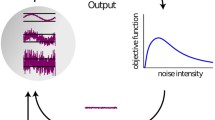Abstract
The dendritic cell algorithm (DCA) has been applied successfully to a diverse range of applications. These applications are related by the inherent uncertainty associated with sensing the application environment. The DCA has performed well using unfiltered signals from each environment as inputs. In this paper we demonstrate that the DCA has an emergent filtering mechanism caused by the manner in which the cell accumulates its internal variables. Furthermore we demonstrate a relationship between the migration threshold of the cells and the transfer function of the algorithm. A tuning methodology is proposed and a robotic application published previously is revisited using the new tuning technique.












Similar content being viewed by others
References
Al-Hammadi Y, Aickelin U, Greensmith J (2008) DCA for Bot Detection, Submitted for The 2008 IEEE World Congress on Computational Intelligence (WCCI 2008), Hong Kong
Campelo F, Guimares FG, Igarashi H, Ramirez JA, Noguchi S (2006) A modified immune network algorithm for multi-modal electromagnetic problems. IEEE Trans Magn 42:1111–1114
Castelnovi M, Miozzo M, Scalzo A, Piaggio M, Sgorbissa A, Zaccaria R (2003) Surveillance robotics: analysing scenes by colours analysis and clustering. CIRA
Everett H, Gilbreath G, Heath-Pastore T, Laird R (1994) Controlling multiple security robots in a warehouse environment. AIAA/NASA conference on intelligent robots
Freitas AA, Timmis J (2007) Revisiting the foundations of artificial immune systems for data mining. IEEE Trans Evol Comput 11(4):521–540
Greensmith J (2007) The dendritic cell algorithm. PhD Thesis. The University of Nottingham
Greensmith J, Aickelin U, Twycross J (2006) Articulation and clarification of the dendritic cell algorithm. ICARIS’06
Greensmith J, Twycross J, Aickelin U (2006) Dendritic cells for anomaly detection. Congress on evolutionary computation (CEC)
Greensmith J, Aickelin U, Cayzer S (2005) Introducing dendritic cells as a novel immune inspired algorithm for anomaly detection. ICARIS’05
Hart E, Timmis J (2008) Application areas of AIS: the past, the present and the future. Appl Soft Comput 8:191–201
Ifeachor EC, Jervis BW (2001) Digital signal processing: a practical approach. Prentice Hall, Englewood Cliffs, ISBN 978-0201596199
Kim J, Bentley PJ, Wallenta C, Ahmed M, Hailes S (2006) Danger is ubiquitous: detecting mis-behaving nodes in sensor networks using the dendritic cell algorithm. ICARIS ’06
Lutz MB, Schuler G (2002) Immature, semi-mature and fully mature dendritic cells: which signals induce tolerance or immunity? Trends Immunol 23(9):991–1045
Matzinger P (1994) Tolerance danger and the extended family. Ann Rev Immunol 12:991–1045
Oates R, Greensmith J, Aickelin U, Garibaldi J, Kendall G (2007) The application of the dendritic cell algorithm to a robotic classifier. ICARIS’07
Pastore T, Everett H, Bonner K (1999) Mobile robots for outdoor security applications. ANS’99
Saitoh M, Takahashi Y, Sankaranarayanan A, Ohmachi H, Marukawa K (1995) A mobile robot testbed with manipulator for security guard application. IEEE international conference on robotics and automation
Strang G, Nguyen T (1996) Wavelets and filter banks. Wellesley-Cambridge Press, ISBN 978-0961408879
Swain M, Ballard D (1991) Color indexing. Int J Comput Vis 7(1)
Taylor D, Corne D (2003) An investigation into negative selection algorithm for fault detection in refrigeration systems. ICARIS’03. Springer, Heidelberg, pp 34–45
Young SS (2001) Computerized data acquisition and analysis for the life sciences. Cambridge University Press, Cambridge. ISBN 978-0521565707
Zhong Y, Zhang L, Huang B, Li P (2006) An unsupervised artificial immune classifier for multi/hyperspectral remote sensing imagery. IEEE Trans Geosci Remote Sens 44:420–431
Acknowledgments
The authors would like to thank Dr. Gordon Wyeth of the University of Queensland for his technical insight and support; William Wilson and Phil Birkin for their recommendations and suggestions throughout the derivation process and Heather Chapleo for her assistance during the practical experiments. This project is financially supported by MobileRobots Inc.
Author information
Authors and Affiliations
Corresponding author
Rights and permissions
About this article
Cite this article
Oates, R., Kendall, G. & Garibaldi, J.M. Frequency analysis for dendritic cell population tuning. Evol. Intel. 1, 145–157 (2008). https://doi.org/10.1007/s12065-008-0011-y
Received:
Revised:
Accepted:
Published:
Issue Date:
DOI: https://doi.org/10.1007/s12065-008-0011-y




